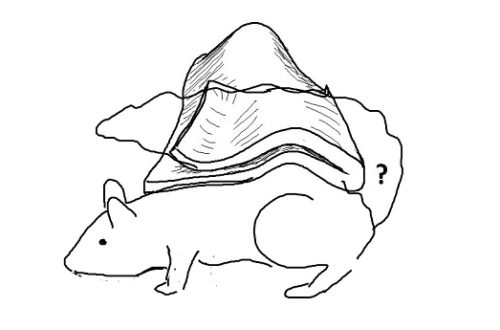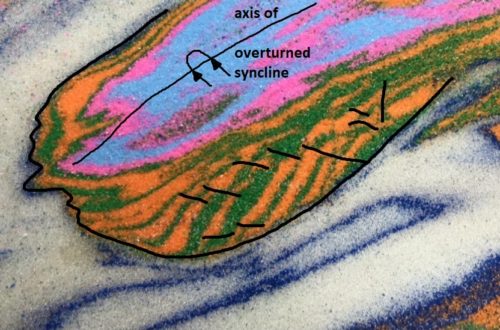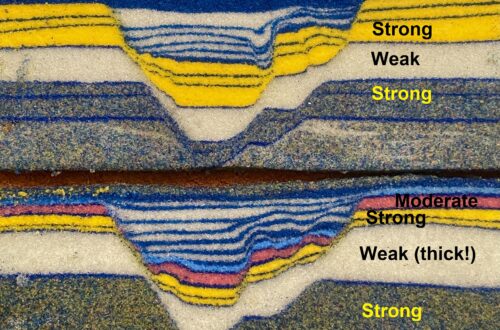
The Blacks Beach landslide: Why did part of the beach rise as the cliffside slid down?
by Philip S. Prince
The January 20, 2023, landslide at Blacks Beach near La Jolla, California, dramatically uplifted a small portion of the beach during the slide’s movement. Filmmaker Kent Ameneyro captured the uplift sequence in great detail in the YouTube video linked here. From ground level, the uplift is very dramatic, particularly against the backdrop of the downward displacement of the steep slope above it. The image below is a screenshot from the Ameneyro video, with large yellow arrows indicating the general movement. The small red arrows up the cliff indicate visible offset as the slide block moves.

The beach uplift produces an understandable reaction from onlookers, and many of the early comments on the YouTube video focused on why it occurred. In this case, the uplift is directly related to what is below the land surface–weak mudstone layers that provide a nice slide plane underneath the base of the slope and the beach. I made the model shown below about a year ago to illustrate this slope failure scenario, and Blacks Beach provides a nice opportunity to relate it to a real-world slide that happened to be filmed (the model wasn’t!). The weak layer and its depth below the model surface allowed failure of the sand layers to extend beyond the base of the slope, driving the the toe of the slide up as the head of the slide sank down to produce a headscarp and sag. The downward motion at the head of the slide thus drives the upward motion of the toe.
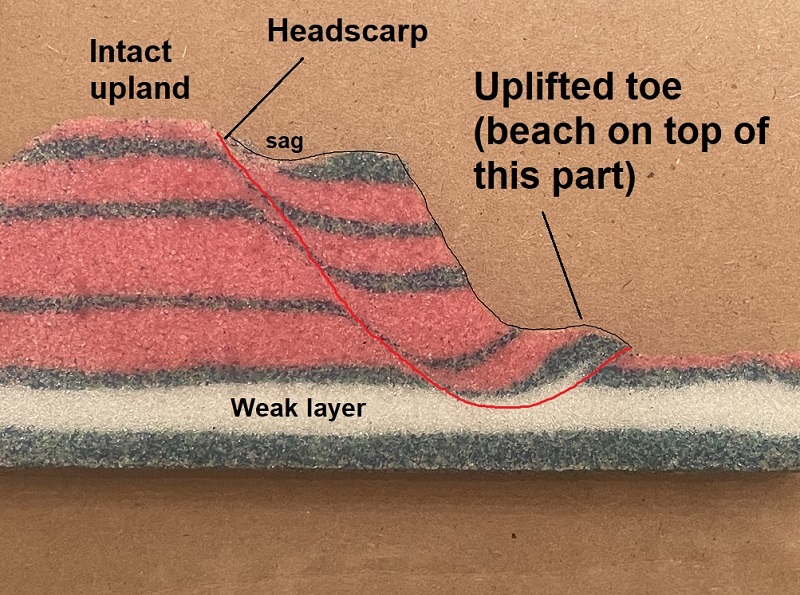
The image below uses arrows to illustrate this general motion.
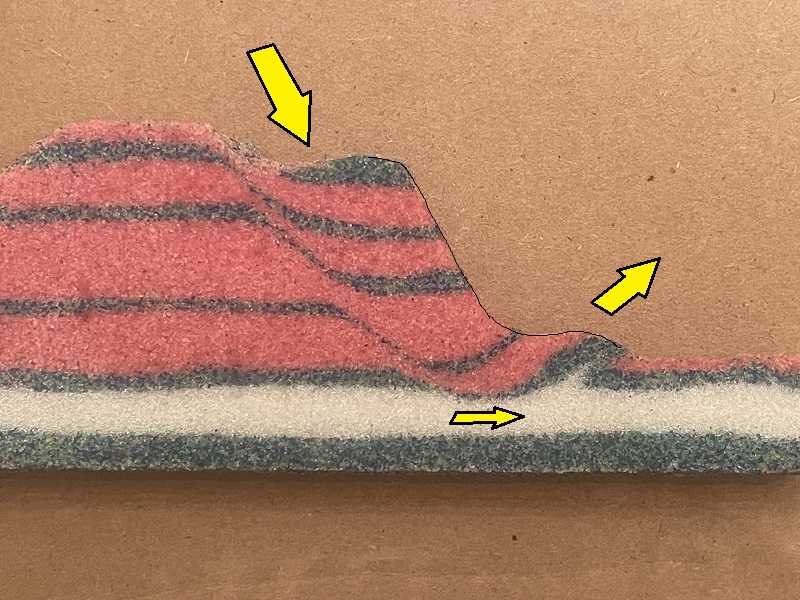
The model in the GIF below portrays this process from the landscape view. If the model were cut away like the one above, a similar pattern would be present. Again, a weak layer well below the base of the slope causes the slope and a portion of its base to move together, with downward motion of the slope causing outward and upward motion of the toe. Movement of the darker sand layers beyond the base of the slope starts as soon as the top of the slide begins to move downward, showing that the areas are linked along the same sliding surface. The light material of the slope isn’t really pushing or “bulldozing” the dark sand; the dark sand is moving along with the rest of the slope due to the underlying weak layer. Were the weak layer absent, layers beneath the flat ground beyond the slope base would not give way under the load of the slope. The light-colored slope material would slide out, and on top of, the dark sand at the slope base.
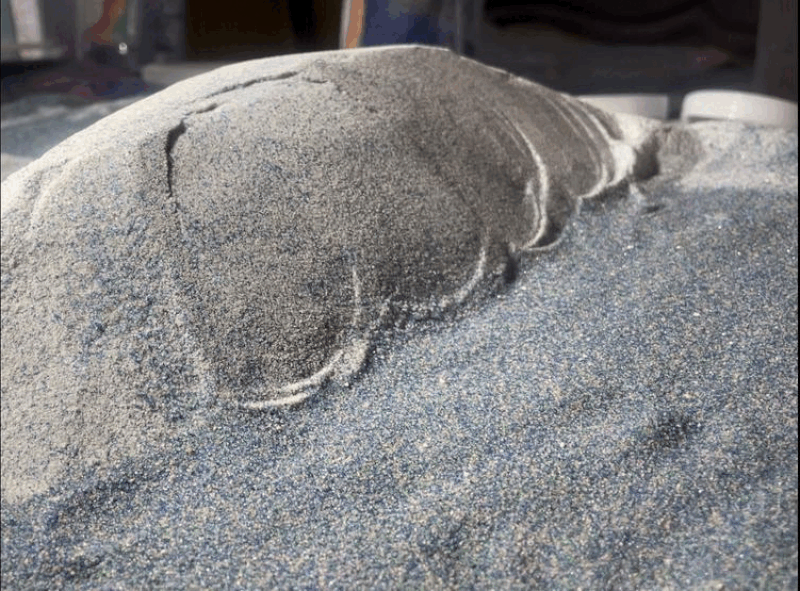
I drafted a basic cross section onto the image below. The red lines indicate the failure surface, which passes from the strong material down into the weak material to reach beyond the base of the slope.
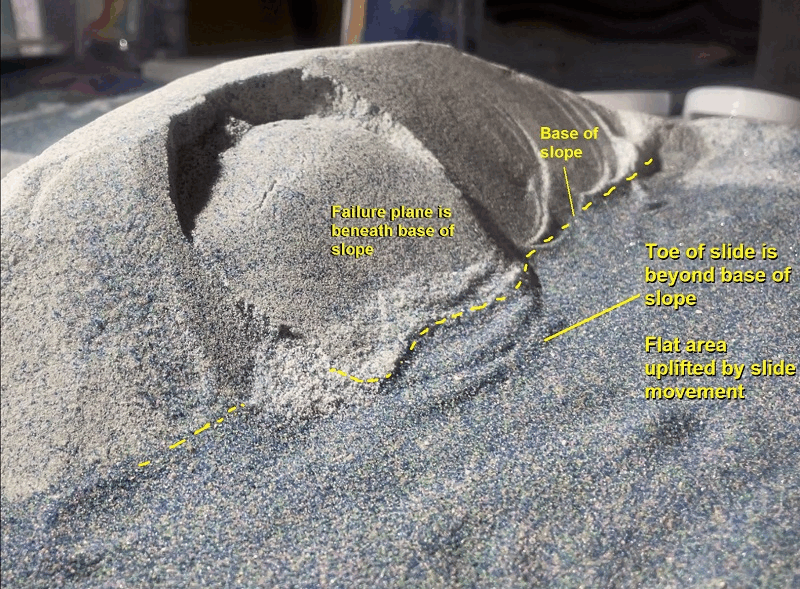
Looking at the real Blacks Beach slide from above, the same overall pattern is present. Notably, beach uplift occurred in a fairly small area. This may be a result of greater displacement of the slide block in this area, or failure may have occurred at the toe of the slope in other areas and remained above the deeper mudstones. The image was sourced from this video.
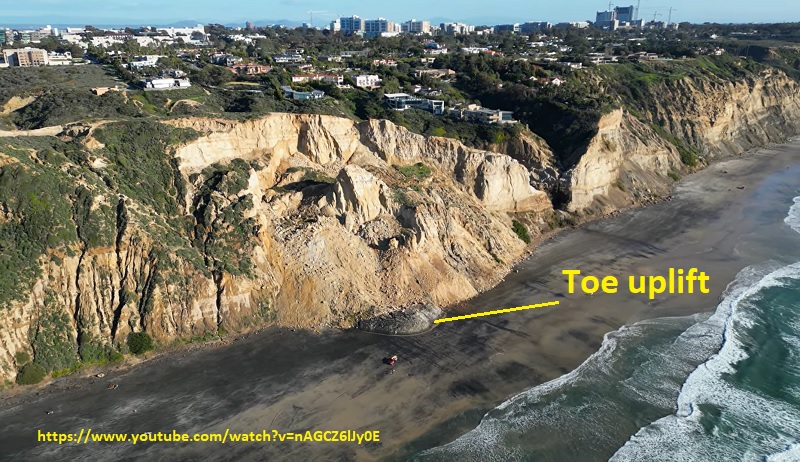
The Blacks Beach area has a history of slope failures (there was a big one here in 1982), and the January 2023 event certainly won’t be the last movement at this location. Erosion of the lower part of the slide by ocean waves continually destabilizes the slope, leading to more movement. The model shown in the GIF below demonstrates this process and is essentially a more “evolved” version of the previous GIF. I scraped away the lower part of the slide after initial movement, which led to development of a new failure surface within the initial slide mass. The lower slide block moves first, uplifting the dark sand beyond the base of the slope. The upper slide block then moves slightly. This sort of irregular movement can occur in reactivated slides as they shift and adjust to try to reestablish equilibrium between material strengths and gravitational force. As with the previous GIF, compression and uplift of the dark sand beyond the slope base occurs in conjunction with the downward movement of the upper part of the slide.
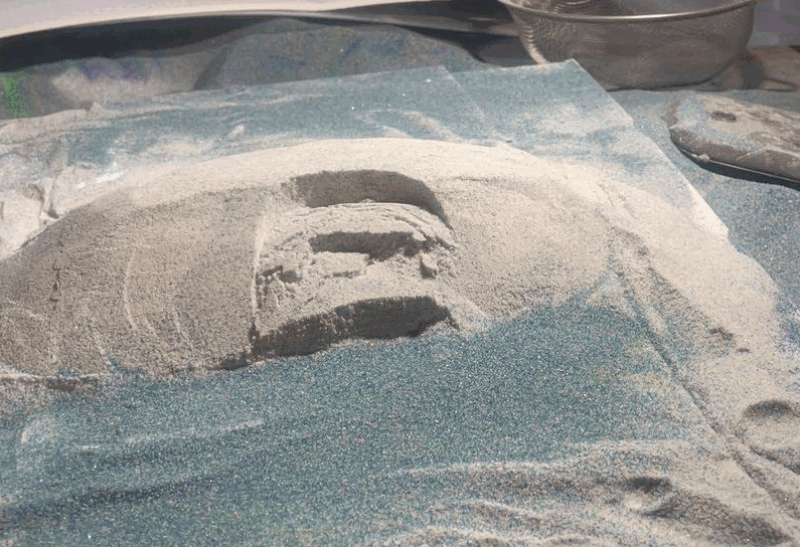
The respective scarps, the eroded portion near the base of the slide, and the uplifted toe are labeled in the image below.

I think the additional images below just look cool. The slope in this model was made of “strengthened” sand, which fractured and broke apart nicely to replicate surface rock mass behavior.

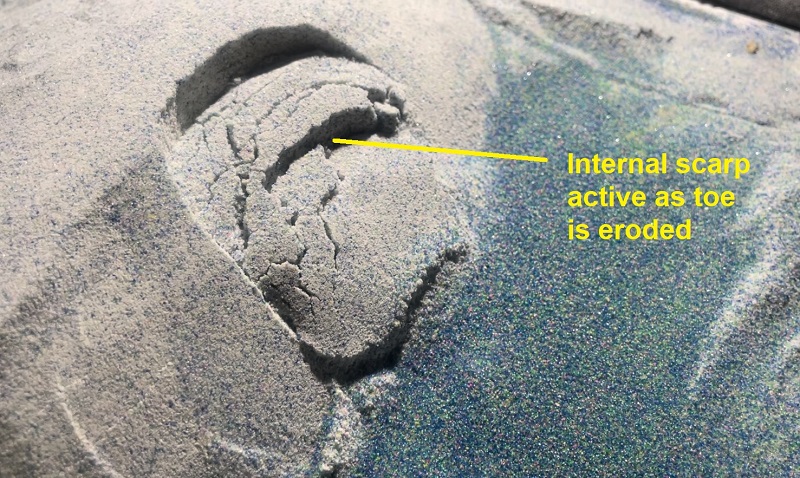
Erosion undoubtedly plays a major role in past, present, and future activity of the Blacks Beach slide. Development of the uplifted toe provides a “counterweight,” so to speak, to resist additional slide movement. Erosional removal of the toe eliminates this resisting force and sets the stage for more movement. Kent Ameneyro did a great job of documenting the slide about a week after its occurrence, capturing great video of the eroded remnant of the uplifted area. The image below is a screen shot from his video, with a dashed line projection of the eroded material. The upturned layers that were within the toe are clearly visible.
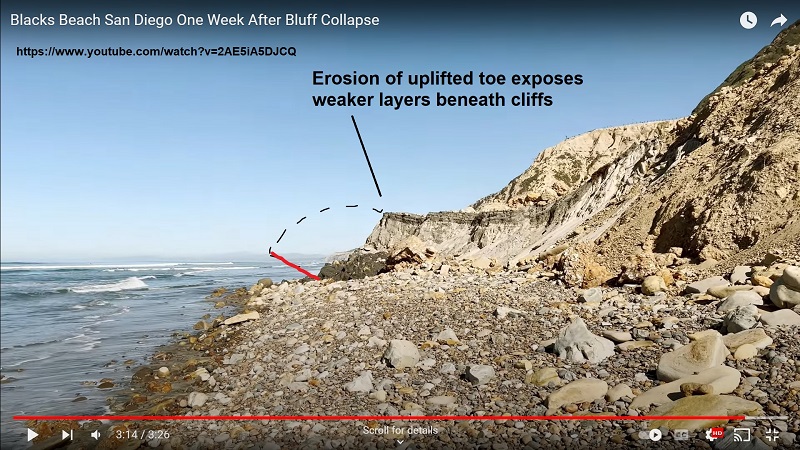
The screenshot below from this video shows a zoomed-out view. Considerable erosion of the entirety of the slide toe (not just the uplifted beach portion) can be seen.
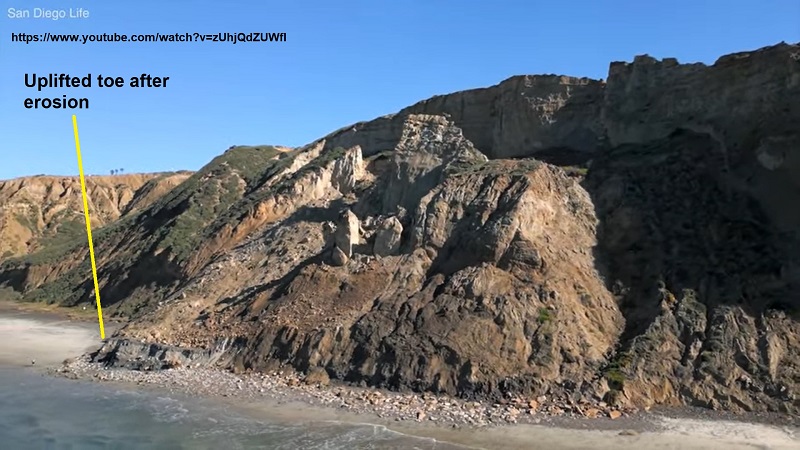
Like many large-scale landslides with intermittent movement, the Blacks Beach slide area (the overall “slump complex”) is clearly visible in lidar-derived imagery. The GIF below fades a lidar overlay in and out to allow comparison of aerial topography to lidar imagery. The January 2023 movement is not shown here, but I attempted to outline the area that moved with solid yellow lines. The dashed line shows the older, uppermost headscarp. The uplifted toe is generally sketched in black.
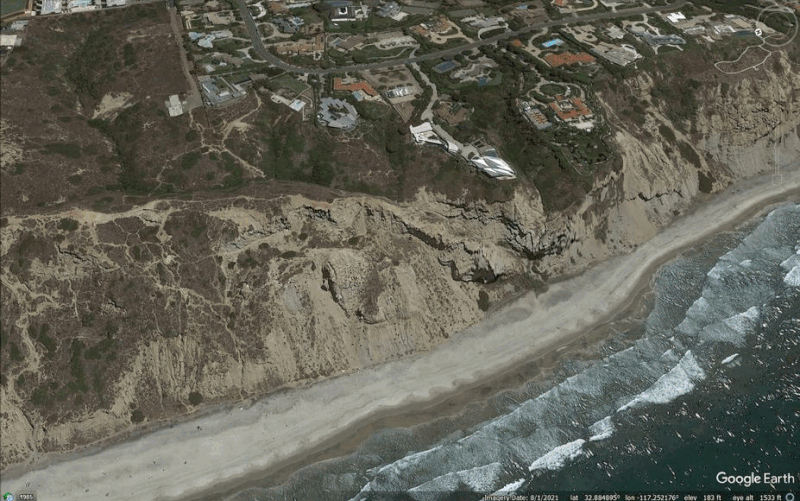
Seeing a base failure landslide like this one professionally recorded first hand, and at close range, is truly remarkable. All of the videos of this failure, even those taken after, provide great information about how the slide developed and continues to evolve. Due to its size and location, stabilization certainly isn’t feasible, so all folks can do is sit back and wait for the next episode of movement!


